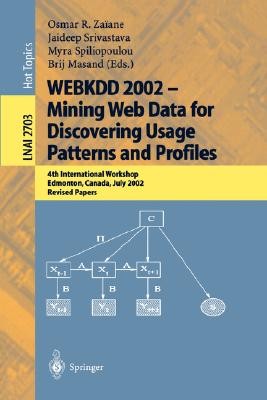| Webkdd 2002 - Mining Web Data for Discovering Usage Patterns and Profiles: 4th International Workshop, Edmonton, Canada, July 23, 2002, Revised Papers 2003 Edition Contributor(s): Zaiane, Osmar R. (Editor), Srivastava, Jaideep (Editor), Spiliopoulou, Myra (Editor) |
|
 |
ISBN: 3540203044 ISBN-13: 9783540203049 Publisher: Springer OUR PRICE: $52.24 Product Type: Paperback - Other Formats Published: October 2003 |
| Additional Information |
| BISAC Categories: - Computers | Intelligence (ai) & Semantics - Computers | Information Technology - Computers | Databases - General |
| Dewey: 006.3 |
| LCCN: 2003059234 |
| Physical Information: 0.42" H x 6.14" W x 9.21" (0.62 lbs) 183 pages |
| Descriptions, Reviews, Etc. |
| Publisher Description: 1 WorkshopTheme Data mining as a discipline aims to relate the analysis of large amounts of user data to shed light on key business questions. Web usage mining in particular, a relatively young discipline, investigates methodologies and techniques that - dress the unique challenges of discovering insights from Web usage data, aiming toevaluateWebusability, understandtheinterestsandexpectationsofusersand assess the e?ectiveness of content delivery. The maturing and expanding Web presents a key driving force in the rapid growth of electronic commerce and a new channel for content providers. Customized o?ers and content, made possible by discovered knowledge about the customer, are fundamental for the establi- ment of viable e-commerce solutions and sustained and e?ective content delivery in noncommercial domains. Rich Web logs provide companies with data about their online visitors and prospective customers, allowing microsegmentation and personalized interactions. While Web mining as a domain is several years old, the challenges that characterize data analysis in this area continue to be formidable. Though p- processing data routinely takes up a major part of the e?ort in data mining, Web usage data presents further challenges based on the di?culties of assigning data streams to unique users and tracking them over time. New innovations are required to reliably reconstruct sessions, to ascertain similarity and di?erences between sessions, and to be able to segment online users into relevant groups |